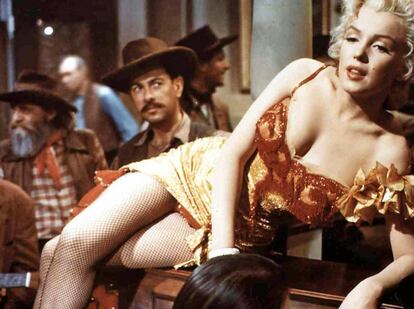‘Brainwashed: Sex, Camera and Power’: The documentary that analyzes cinema’s toxic male gaze
Independent director Nina Menkes’s film triumphed at the Sundance Film Festival. Now her dissection of women’s sexualization in the movies can be seen on TCM

Independent director Nina Menkes’s documentary Brainwashed: Sex, Camera and Power gives women — and men who regard us as equals — another good reason to be angry. The film premiered on March 8 on TCM. If I were you, I would learn it by heart so that whenever a man — especially a reputable film critic—tries to explain things to us, we can give him examples in response (in the rare moments that he lets us participate in the conversation at all).
What does the documentary tell us? Well, something we already knew but did not really know, something we had seen, sensed but internalized as natural or even forgotten that we knew. The documentary begins by quoting the writer James Baldwin: “Not everything that is faced can be changed, but nothing can be changed until it is faced.”
Menkes dissects the sexualization of women in cinema and what that has meant in our minds, in our collective imagination. She unflinchingly talks about how the great and unquestionable masters of cinema have been using a visual language that has objectified women for centuries (the films she analyzes range from 1895 to the present day). By placing women in their films as passive objects (the man-who-looks-at-the-woman-who-just-looks, where the man is the subject and the woman is the object), for cinema’s entire history, without ever being directly called out for it, filmmakers have managed to create an entire world of labor discrimination, sexual harassment within the entertainment industry, and infamous unspoken agreements; in turn, these effects have bled into everything else, including how we understand the world, relate to each other, conform, give orders, pontificate.
Menkes shows 175 sequences taken from the untouched works of an imposing list of filmmakers, including Tarantino, Scorsese, Welles, Minelli, Lynch, Anderson, Sophia Coppola, Godard, Kubrick, Wenders and Hitchcock, just to name a few. They are stellar scenes that we all love; we’ve never questioned them and we’ve even celebrated them. But they all follow the same pattern: they sexualize and objectify women’s bodies. We are talking about top-notch films, the ones that win prizes at Cannes and similar festivals, cult classics, outstanding works. Year after year, these movies represent the best of the best, they’re unmissable and form part of the annals of film history.
How did the idea for the documentary come to Menkes in the first place? As the filmmaker herself explains in a videoconference, “In talks at film schools, I used to show how films recorded men and women differently and how it was so obvious and so normalized that no one in the audience… noticed it.”
But then came 2017 and the Harvey Weinstein case. Amid that “epidemic of sexual harassment,” Menkes was encouraged to write an essay from the same perspective of her lectures: what the issue was, what it meant, how the visual language in film was also based on harassment, and how all of that had repercussions for other issues, like employment discrimination. “To me, that visual language manifests itself in every scene, connecting everything, and that was what I wanted to tell,” she notes. The essay went viral; it was the most read essay of the year. In 2018, Menkes went to the Cannes Film Festival where she gave a masterclass entitled Sex and Power: The Visual Language of Oppression. She went on tour discussing that topic, and everyone encouraged her to make a film about it.
“Before [the] Harvey [Weinstein scandal], it wouldn’t have been financed, and if it had been, it wouldn’t have been shown. I was surprised by people’s surprise; anyone who has gone to film school has seen it clearly, they’ve read about it, and despite that, they still use the same visual codes. It’s brainwashing. When I started I said, but isn’t it obvious? Well, no, it’s obvious to you,” the filmmaker explains.
With the success of the essay and the talks, amid a new ecosystem in which the magnitude of the tragedy was clear and #MeToo was in the spotlight, they made the film and sent it to Sundance without much enthusiasm. But the people at Robert Redford’s festival watched it; it shocked them, and they selected it. “It’s so normalized…that you’re surprised it hasn’t shocked you before, you know it’s there, but you skip over it. We were very excited that a festival like this selected us.”
In talking about this documentary, film journalist María Guerra—with whom I have long, brainy and angry conversations about feminism and the entertainment industry—reminds me that, for example, revered filmmaker Jean-Luc Godard (the representative par excellence of French Novelle Vague cinema) said that “to make a film all you needed was a woman and a gun.” Two objects, then. Menkes observes that “Godard, with his experimental cinema, approaches women but he is not experimenting at all, and he is quite sexist, something that nobody cites in critical texts about him. In fact, when he died I was surprised by the fact that not a single person mentioned his work’s extreme sexism. We women are still in a category of oppression that remains so delicate.”
In her documentary, Menkes employs the concept that film theorist Laura Mulvey coined in 1975 in her essay “Visual Pleasure and Narrative Cinema: The Male Gaze.” Mulvey wanted to demonstrate that cinema and the entertainment industry in classical Hollywood (1930-1950) started from a social unconscious formed by the dominant order, which is none other than the patriarchal order itself. Menkes goes on to conclude that all the cinema that we have consumed has been designed for the male and heterosexual spectator to enjoy. And “we have also been taught to enjoy those cute, sexy images.” We have educated our [vision] with the same canon, which is why this documentary is shocking. That’s why we don’t see that Rita Hayworth’s glamour is as aspirational as it is unattainable until Menkes points it out to us.
María Guerra argues that Menkes belongs to “a generation that the industry ignored, like so many other women”; she’s not the first to reclaim this discourse. Before her, there was the Bechdel test, Mulvey herself, and many other works done over the years, similar to this one, that break down a reality and try to get through to the oblivious, but the patriarchy’s inertia is enormous. “When I saw the film it reminded me of Velázquez’s Venus at Her Mirror. There’s the original sin; she is the woman without a face, the idealized woman’s body but without an identity. You have no interest in who she is,” Guerra says.
Menkes’ film—which is more powerful as a didactic, informative, redemptive document than as a cinematographic work—reveals to us how we have looked in the past and how we continue to look: through the gaze of machismo. As Guerra says, we need “a documentary of this type every six months. Many of these filmmakers and critics question commercial and industrial cinema, but their sin is that they do so from their unrecognized male privilege.”
Some of the 175 examples that Menkes includes in her documentary: The close-up of Ana de Armas’s full lips sucking on an ice cube in Blade Runner. The horizontal and vertical and slow-motion panning of women’s bodies, which are always sexualized, eroticized, as in Suicide Squad, as opposed to the slow-motion panning of men’s bodies, which are framed in action scenes. Rosana Arquette’s character’s exposed corpse in Scorsese’s After Hours. That back shot of Nicole Kidman undressing in Stanley Kubrick’s Eyes Wide Shut (she takes off her dress with her heels on, which is something women DON’T usually do, really. There’s no one in the room; she undresses that way just for Stanley and the viewer). Marilyn Monroe in River of No Return, the only woman, dressed in heels and a very tight and low-cut dress/corset on the piano, being watched by a large group of cowboys, who, we assume, are in heat...
While the camera is predatory, the documentary tells us, so, too, is culture. We already knew that there was misogyny in the scripts and in the construction of characters. But Menkes’s film goes further to explain that it is not only the subject and the object that matter, but also the framing, the lighting, the narrative position, the design of the shots. All creations by cis heterosexual men (directors, cinematographers, technicians) have basically been made to please that same audience, perpetuating the positions of power.
The proliferation of this type of shot, Menkes says in the talk that gave rise to her documentary, is propaganda for the patriarchy. What is normalized as beauty “is seen through that male gaze.” One of the film’s conclusions is that this visual language fosters self-contempt and insecurity in women. Another is that the female gaze has often been eclipsed or erased, even by women behind the camera, as in Hostile Earth. Another, even more, important contribution is that the film contradicts none other than one of the stalwarts of film criticism, André Bazin, the founder of the legendary magazine Cahiers du Cinéma. Bazin said that “cinema shows us a world that satisfies our desires.” Well, André, let me tell you something: it doesn’t fulfill mine or those of thousands of my female colleagues. The women in that cinema who are always victims of romantic love and never political subjects “do not represent us, we don’t want them, we don’t need them,” Guerra exclaims.
Neither Menkes nor any of the experts in the documentary ever say that these masterpieces are not good films. They simply mean to point out that the films are the canon; they have been placed at the center of the story, but that is not the story of women. I agree, as does Maria Guerra: “We don’t blame men; we just want to unmask the situation again and again and again and get all the facts out. We’re not going to walk away from the public debate anymore.” One can criticize Scorsese, Tarantino and Hitchcock and admit that their films had some imperfections that no one ever noticed, which are simply harmful to the common good.
Following the documentary’s success, Menkes has been encouraged to bring it to television as a docuseries, a kind of spin-off to the film. But there’s a catch: “It takes about $5 million. It’s funny, it’s easier to narrate the end of the world than the end of capitalism or the end of patriarchy. There is a lot of apocalyptic cinema and practically none on this subject,” she says. To wit: each episode of the post-apocalyptic series, The Walking Dead, based on Robert Kirkman’s comic book, cost $3.1 million; there have been 11 seasons of the show. The show Lost was filmed in 2004; the two-part pilot cost $14 million.
Let’s get this spin-off on television, please.
Sign up for our weekly newsletter to get more English-language news coverage from EL PAÍS USA Edition
Tu suscripción se está usando en otro dispositivo
¿Quieres añadir otro usuario a tu suscripción?
Si continúas leyendo en este dispositivo, no se podrá leer en el otro.
FlechaTu suscripción se está usando en otro dispositivo y solo puedes acceder a EL PAÍS desde un dispositivo a la vez.
Si quieres compartir tu cuenta, cambia tu suscripción a la modalidad Premium, así podrás añadir otro usuario. Cada uno accederá con su propia cuenta de email, lo que os permitirá personalizar vuestra experiencia en EL PAÍS.
¿Tienes una suscripción de empresa? Accede aquí para contratar más cuentas.
En el caso de no saber quién está usando tu cuenta, te recomendamos cambiar tu contraseña aquí.
Si decides continuar compartiendo tu cuenta, este mensaje se mostrará en tu dispositivo y en el de la otra persona que está usando tu cuenta de forma indefinida, afectando a tu experiencia de lectura. Puedes consultar aquí los términos y condiciones de la suscripción digital.
More information
Archived In
Últimas noticias
Most viewed
- Sinaloa Cartel war is taking its toll on Los Chapitos
- Reinhard Genzel, Nobel laureate in physics: ‘One-minute videos will never give you the truth’
- Oona Chaplin: ‘I told James Cameron that I was living in a treehouse and starting a permaculture project with a friend’
- Why the price of coffee has skyrocketed: from Brazilian plantations to specialty coffee houses
- David King, chemist: ‘There are scientists studying how to cool the planet; nobody should stop these experiments from happening’










































